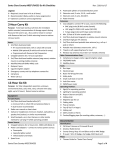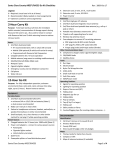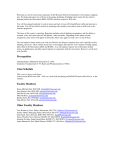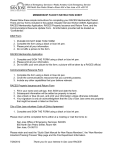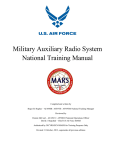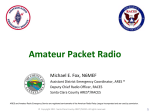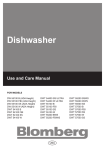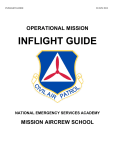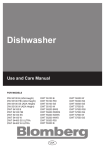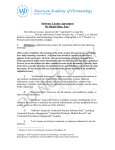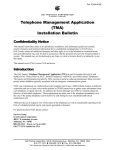Download Performance Standards and Best Practices
Transcript
Santa Clara County ARES®/RACES
Performance Standards
and Best Practices
Version 1.0.4 -- Last Revised: 2011-May-30
Performance Standards and Best Practices
v1.0.4 -- Rev: 2011-May-30
Copyright © 2009, 2010, 2011 by
Larry Carr, Jim Clark, Michael Fox, Doug Kalish, Pat Moore, Scott Morse, Al Whaley.
All rights reserved.
Santa Clara County ARES®/RACES
Page 2 of 23
Performance Standards and Best Practices
v1.0.4 -- Rev: 2011-May-30
Contents
USAGE GUIDELINES ................................................................................................................................................ 4
®
RECOMMENDED FOR ALL ARES /RACES COMMUNICATORS..................................................................................................4
REQUIRED MINIMUM STANDARD FOR MUTUAL AID COMMUNICATORS ....................................................................................4
MAINTAIN IN GO KIT ......................................................................................................................................................4
USE OF GOOD JUDGMENT................................................................................................................................................4
UPDATES AND NOTICES ...................................................................................................................................................4
PROFESSIONALISM AND TRAINING ........................................................................................................................ 5
COMMUNICATIONS TECHNIQUE ............................................................................................................................ 7
SAFETY ................................................................................................................................................................... 8
METHODS AND PROCEDURES .............................................................................................................................. 10
General................................................................................................................................................................10
Field Communications .........................................................................................................................................12
Net Control ..........................................................................................................................................................13
Shadow Communications....................................................................................................................................13
Packet Communications......................................................................................................................................14
HF Communications ............................................................................................................................................16
EQUIPMENT ......................................................................................................................................................... 17
General................................................................................................................................................................17
Clothing and Personal Gear ................................................................................................................................17
Portable Equipment ............................................................................................................................................18
Mobile FM Equipment.........................................................................................................................................18
Packet Equipment ...............................................................................................................................................19
HF Equipment......................................................................................................................................................19
DOCUMENTATION ............................................................................................................................................... 21
NOTES .................................................................................................................................................................. 22
REVISION HISTORY............................................................................................................................................... 23
Santa Clara County ARES®/RACES
Page 3 of 23
Performance Standards and Best Practices
v1.0.4 -- Rev: 2011-May-30
Usage Guidelines
Recommended for all ARES®/RACES Communicators
The best practices contained in the following pages document the RECOMMENDED performance
standard for emergency communications in Santa Clara County ARES®/RACES. These best practices are
a distillation of the ongoing training provided within the county and the experience gained from realworld incidents. All participants in ARES®/RACES activities should strive to perform their assignments
according to this standard.
Required Minimum Standard for Mutual Aid Communicators
Mutual Aid Communicators (MACs) are amateur radio operators who have volunteered their time, their
expertise, and their equipment to provide communications services during times of need. These
individuals are trained and prepared to provide a variety of communications services and are available
for deployment throughout the county, according to the county mutual aid mechanisms.
The best practices contained in the following pages document the REQUIRED MINIMUM performance
standards which apply to all Santa Clara County MACs, at all times. Additional standards may apply to
higher qualification levels. The goal of every Santa Clara County MAC should be to stay so well trained
and practiced that he/she regularly adheres to these standards without a second thought.
Maintain in Go Kit
All Santa Clara County MACs must maintain a copy of these standards in their Go Kit at all times. This
makes it convenient to refer to them prior to initiating an assignment. They can also serve as a
reference for use during an assignment.
Use of Good Judgment
All Santa Clara County ARES®/RACES communicators are expected to exercise good judgment in the
application of these standards to real world situations. Everyone should adhere to all standards that are
applicable to and appropriate for their specific assignment. When unsure about the application of a
particular standard, the individual should seek clarification and guidance from his/her supervisor or net
control. In all cases, an amateur radio operator should never do anything that would jeopardize the
safety of themselves or others.
Updates and Notices
Revisions to this standard take effect two weeks from notification. Notices of updates to this standard
are sent to the SCC-RACES-MACS Yahoo mailing list and posted on the www.scc-ares-races.org website.
Updates are published no later than two weeks before a scheduled County drill or event, and are not
released more frequently than 30 days from the previous revision.
Santa Clara County ARES®/RACES
Page 4 of 23
Performance Standards and Best Practices
v1.0.4 -- Rev: 2011-May-30
Professionalism and Training
•
•
•
•
•
Understands Assignment
o Demonstrates knowledge and purpose of assignment
o Properly documents assignment
e.g. Activation number and other details provided by supervisor or Net Control
Maintains positive control of assignment
o Stays focused and on task
o Remains composed under stressful conditions
o Properly prioritizes tasks and handles overload situations calmly
o Advises supervisor or Net Control of any change in status or location
e.g. Breaks, physical and environmental changes, changes in communications
activity level, etc.
Functions effectively as a team member
o Effectively shares work assignments with other team members
o Follows instructions and performs assigned tasks politely and proactively
o Works cooperatively with leaders and co-workers
o Keeps the team informed of his/her progress, status
o Maintains a polite and respectful relationship, even under stress
o Actively volunteers to help the team
o Respects the efforts and responsibilities of each volunteer and professional
Functions in a helpful, positive, professional way with served agency at all times
o Introduces him/herself to served agency team leader and other key individuals
o Maintains an advisory type of relationship for communications functions
o Coordinates communications activities with the rest of the served agency team
o Communicates effectively using served agency’s protocols
o Adapts to the particular procedures and needs of the served agency and/or situation
o Maintains a list of served agency contact numbers for use during the assignment
o Handles disagreements with served agency professionally
i.e. Exercises restraint and remains professional; doesn’t argue; informs
supervisor or Net Control promptly
o Promptly follows directions of Police/Fire
o Coordinates demobilization of communications operations with served agency
Functions fully independently for length of 8 hour assignment
o Demonstrates preparedness for 12 hours (go kit, personal readiness)
o Attests to physical, mental, emotional, readiness for 8 hour shift
o Communicates any limitations prior to accepting an assignment
e.g. Physical, mental, emotional, equipment, schedule, etc.
o Communicates any changes in status during the assignment
e.g. Physical, mental, emotional, equipment, schedule, etc.
Santa Clara County ARES®/RACES
Page 5 of 23
Performance Standards and Best Practices
•
v1.0.4 -- Rev: 2011-May-30
o Demonstrates ability to perform the assignment he/she accepted
Seeks out and participates in training on a regular basis
o Participates in training courses to stay abreast of current standards and techniques
o Participates in drills and public service events to maintain and improve operating skill
o Contributes own experience to the interaction that occurs during training and drills
Santa Clara County ARES®/RACES
Page 6 of 23
Performance Standards and Best Practices
v1.0.4 -- Rev: 2011-May-30
Communications Technique
•
•
•
•
Verbal communication is effective, clear and concise
o Maintains a clear speaking voice
o Controls tone of voice, even under stress
o Has a good command of the English language
o Has good hearing and is able to copy traffic accurately
o Uses plain English, no 10-codes, Q-codes, etc.
o Properly uses/pronounces letters and numbers
o Properly uses phonetics and can recite all ITU standard phonetic letters
o Properly speaks numbers, including multi-digit numbers and decimal points
o Properly uses ProWords like “say again,” “all after,” “word before,” etc.
o Communicates time using 24-hour local time; unless otherwise instructed
o Formulates thoughts before keying mic; avoids saying “uhhh”
Radio technique is effective
o Makes only necessary transmissions
o Uses procedures and techniques to reduce the number of transmissions
o Uses a minimum of words to convey a message
o Leaves pause at beginning of transmission to allow repeater to key up
o Leaves sufficient gaps between transmissions for others to break in
o If repeaters are linked, leaves an even longer pause at beginning of transmission and an
even longer gap between transmissions
o Drops PTT when not speaking; avoids “open mic” or “dead air”
Written communication is effective, clear and concise
o Message forms are completed correctly and legibly
o Other standard forms are completed correctly and legibly
o Informal messages are clear, concise and legible
o Writes time as 24-hour local time; unless otherwise instructed
o Logs and other records are clear, concise and legible
Call signs and tactical calls are used properly
o Copies call signs accurately and efficiently
o Is able to explain the purpose and advantages of tactical calls
o Uses tactical calls frequently and properly when communicating
o Properly IDs with FCC call sign at end of transmissions and according to FCC regulations
Santa Clara County ARES®/RACES
Page 7 of 23
Performance Standards and Best Practices
v1.0.4 -- Rev: 2011-May-30
Safety
•
•
•
•
•
•
Actively and continually assesses personal safety
o Restricts activities to the scope of his/her training (communications)
o Calls 911 or other official emergency number if fire, medical or public safety issue exists
o Wears proper attire for the situation
e.g. sturdy footwear, long pants, work gloves, safety glasses, outdoor work
clothing, protection from cold, heat, sun, wind and rain
o Maintains awareness of surroundings and potential for safety issues
o Drives safely and does not speed
o Does not drive off road unless specifically authorized to do so
o Does not go anywhere that he/she feels is not safe
o Avoids overhead wires when deploying antennas
o Professionally and responsibly withdraws from situations that become risky; advises net
control and served agency promptly
Works to prevent fatigue; recognizes and takes action to deal with fatigue
o Works at moderate pace as applicable to the assigned task
o Takes periodic breaks
o Adjusts duties to alternate between heavy and light duty tasks
Works to prevent stress; can recognize and can deal with stress
o Emphasizes teamwork
o Takes regular breaks
o Maintains proper hydration and nutrition
o Rotates positions/duties with team members every few hours
o Notifies net control and coordinates with the served agency if team member is unable
to fulfill role
o Is patient and understanding with other operators who are likely stressed
Takes proper precautions to deal with cold
o Dresses in layers, with wicking layer on bottom
o Uses clothing to reduce exposure to cold and wind
o Rotates positions with other teammates
Takes proper precautions to deal with sun and heat
o Dresses in layers
o Rotates positions with other teammates
o Uses sunscreen, hat and clothing to reduce sun exposure
o Maintains proper hydration
o Makes effective use of shade
Takes proper precautions to deal with lightning
o Avoids use of telephone, radios and other electrical appliances
o Gets out of boats and away from water
Santa Clara County ARES®/RACES
Page 8 of 23
Performance Standards and Best Practices
•
•
•
•
v1.0.4 -- Rev: 2011-May-30
o Takes shelter (in a building if possible, or a closed motor vehicle)
o Finds a low spot away from trees, fences and poles
o Squats low to ground on balls of feet if lightning strike seems imminent
Takes proper precautions to deal with floods
o Stays out of water deeper than six inches
o Does not attempt to cross flowing water, regardless of depth
o Does not drive through flooded roadways
o Stays out of drainage channels
Takes proper precautions to deal with landslides and mudslides
o Stays away from edges and bases of steep slopes
Takes proper precautions to deal with earthquakes
o Stays away from downed power and utility lines
o Does not enter suspect structures
Takes proper precautions to deal with fires
o Does not proceed past a fire line
o Keeps informed of fire weather conditions and forecasts
o Identifies escape routes and safety zones and makes them known to others
o Increases alert level if weather is getting hotter or drier, or if wind increases and/or
changes directions
Santa Clara County ARES®/RACES
Page 9 of 23
Performance Standards and Best Practices
v1.0.4 -- Rev: 2011-May-30
Methods and Procedures
General
The following methods and procedures standards apply to all types of assignments
•
•
Understands and is able to describe the purpose and appropriate usage of the main nets
o Resource Net
Official traffic; type of traffic depends on level of operation
Resource Net Level 1
• Information gathering; initial damage reports
Resource Net Level 2
• City EOC check-ins and referral to city nets
Resource Net Level 3
• Coordination of mutual aid; tracking county resources
o Resource Net repeater coverage (which repeater to use in which part of the county)
Use AA6BT (Resource Net Primary) for initial contact, whenever possible
Use W6ASH (Resource Net North) in Northern part of county
Use N6NAC (Resource Net South) in Southern part of county, South of the
intersection between Highways 101 and 85 (South of San Jose)
o Message Net
Official message traffic for served agencies; typically between city or agency and
county EOC
o Command Net
Official traffic between Operational Area command staff and between EOCs
o Hospital Net
Official traffic between hospitals and the Department of Public Health District
Emergency Operations Center (DEOC/DOC); also between DOC and county EOC
o City Nets
Official traffic within a city; typically between field communicators and the city
EOC
o Tactical Net
Official and unofficial traffic of a local nature
o Packet Net
Similar to message net except messages sent via packet
o EOC Net
The local government radio net between city and county EOCS
Not an amateur frequency but frequently staffed by amateur radio operators
Makes proper use of Resource Net
o Level 1 – Information Gathering
Responds properly to damage survey requests
Santa Clara County ARES®/RACES
Page 10 of 23
Performance Standards and Best Practices
v1.0.4 -- Rev: 2011-May-30
Level 2 – Referral to City Nets
Follows proper city net check-in process
o Level 3 – County resource tracking
Obtains clearance from city before checking in
Checks-in after being released from city
Logs assignment and activation
Communicates travel status: departure, en route, arrival
• Reports ready for departure: street and last 3 digits of odometer
• Reports en route every 15-20 minutes (or as directed by the NCO):
street and last 3 digits of odometer
• Reports arrival on scene
Checks out AFTER check-in/sign-in at assignment
Uses net (similar to above) when moving or changing assignment
Uses net (reverse of above) for return trip home
Passes messages appropriately
o Transmits only facts, not conjecture
o Transmits only information approved by Public Information Officer or Emergency
Manager or other appropriate authority; when in doubt, asks supervisor
o Avoids sending personal or confidential information
o Uses standard ICS position titles and facility names
o Uses plain English (no Q-codes, 10-codes or other jargon)
o Clearly states the quantity and nature of the traffic
e.g. “I have ## {Emergency|Priority|Routine} message(s) for you”
o Ensures message form is properly completed before sending
o Passes or copies messages exactly as written
o Passes messages at a speed which receiving party can copy
o Passes messages five words at a time
o Effectively sends multi-station (broadcast) messages by selecting a “pacer” station and
then polling all stations to confirm receipt
Maintains contact with Net Control
o Maintains contact with at least one NCO at all times, even when changing nets
i.e. check in to the next net prior to checking out of the previous net
o Monitors the net continuously and responds promptly when called
o Notifies Net Control Operator (NCO) if planning to leave the net, even for a few minutes
o Checks in with NCO at least every 30 minutes to verify transmit ability and provide
health & welfare status
o Contacts NCO if no traffic at all (from anyone to anyone) heard on net for 15 minutes to
verify receive
o Advises NCO of any change in conditions
o Reports all unusual or dangerous situations promptly
o Can listen and respond in a noisy/chaotic environment
o
•
•
Santa Clara County ARES®/RACES
Page 11 of 23
Performance Standards and Best Practices
•
•
•
v1.0.4 -- Rev: 2011-May-30
o Gives NCO sufficient notice when requesting a replacement
Keeps logs and records correctly
o Properly checks in and out using ICS 211A Communications Check-In
o Properly and accurately maintains an ICS 214 Unit Activity Log, including the following
minimum information:
Time on scene
Actions taken; events that occur
Time when assignment ends
o For more than occasional message traffic, properly and accurately maintains an ICS 309
Communications Log of incoming and outgoing transmissions – at least call signs/tactical
calls
o Submits logs and records to supervisor at end of shift/event
Follows served agency protocols and procedures, as appropriate
o Check-in, check-out, attendance, badges or other personnel tracking
o Communications protocols specific to the agency
o Informs served agency of changes in situation or conditions
Provides complete and accurate relief briefings, including the following (as appropriate for the
situation)
o Assignment, activation number,
o Served agency and official in charge, including how they are recognized
E.g. vests, hats, badges, etc.
o Frequencies, tactical calls, net station locations, emergency contact numbers
o Who to contact regularly
o Radio, power supply, antenna information
o Nearest telephone: location and number
o Location of toilet, water, food, first aid, and other supplies
o Summary of previous operational period
o Current status of people, resources, incident (as it relates to communications)
o Pending issues for next operational period (if any)
o Introduces replacement to the rest of the team
Field Communications
The following additional standard methods and procedures apply when performing any type of
communications assignment in the field
•
Selects an appropriate operating location
o Easily located by people who need to make use of radio communications
o Convenient for the served agency, ideally, near their own communications station
o As quiet as possible and practical for effective communications
Santa Clara County ARES®/RACES
Page 12 of 23
Performance Standards and Best Practices
•
v1.0.4 -- Rev: 2011-May-30
o Does not block movement or traffic flow (vehicle or otherwise)
o Clear space to deploy antennas
o Safe
Insures adequate visibility and presence
o Deploys “Radio Communications” or other signage (as appropriate)
o Wears vest and hat (as appropriate)
o Deploys traffic cones, beacons or other devices as available and appropriate for safety
and visibility of the operating position – particularly at night
Net Control
The following additional standard methods and procedures apply when performing net control
assignments
•
•
Net Management
o Regularly announces existence and purpose of directed net
e.g. typically every 10-30 minutes as appropriate for traffic level
o Effectively organizes check-in process as appropriate
e.g. by suffix, by city, traffic precedence
o Effectively directs traffic for all net participants
o Enforces net discipline (professionally)
o Allows non-net-related traffic during breaks in net traffic
o Uses instructions which avoid doubles (e.g. “the station ending in …”)
o When multiple stations are standing by, regularly announces stand-by list
o Thanks owners and operators of the repeater at appropriate intervals
o Prepares workspace properly with accessible information (forms, maps, …)
o Assigns tactical call signs as appropriate
Field Management
o Keeps track of status of all stations on the net
o Performs regular health & welfare checks of field resources (typically 30 min.)
o Provides information and status updates, as available, to field on a regular basis
e.g. warnings, advisories, PIO statements, or other appropriate info
o Maintains calm at all times and helps field operators to remain calm
Shadow Communications
The following additional standard methods and procedures apply when performing shadow
communications assignments
•
Effectively manages communications for the assigned principal
o Introduces self
Santa Clara County ARES®/RACES
Page 13 of 23
Performance Standards and Best Practices
v1.0.4 -- Rev: 2011-May-30
Informs principal of why you are there, what capabilities you can provide
i.e. capabilities are limited to communications, not other duties
o Discusses communications expectations with principal
e.g. cell phone, commercial radio, FRS/GMRS
o Understands the role and responsibilities of the principal and what types of
communication are important to the principal
o Keeps principal informed of significant event activities heard on the net which are
appropriate to the principal
o Effectively prioritizes traffic to/from principal so as not to monopolize the net
o Insures that principal is always reachable by Net Control
o Limits activities to communications
Maintains close and continuous contact with the assigned principal
o Stays within an effective distance of the principal
e.g. typically 5-10 feet, but out of the crush
o Remains with principal until relieved by Net Control
o Coordinates bathroom breaks to avoid becoming disconnected from principal
o Exchanges cell phone numbers with principal (when/where appropriate)
o Establishes procedure to reconnect if separated
o Arranges activities so as to stay connected to principal
o
•
Packet Communications
The following additional standard methods and procedures apply when performing packet
communications assignments.
•
•
•
Effectively operates packet message software
o Properly configures Outpost parameters that can change with the operator or specific
incident (call sign, user name, tactical call (if any), BBS); can verify at bottom of Outpost
window (status line)
o Properly prioritizes message traffic
o Creates, saves, edits, sends, retrieves, reviews and prints packet messages
o Uses Outpost “Send/Receive Notification” pop-up window to monitor packet
transmission progress
o Polls node (e.g. Outpost Send/Receive) to verify connectivity, unless otherwise
instructed, if no traffic has been sent or received on this station for 30 minutes,
o Promptly reports any problems to Net Control of message net and to shift supervisor
PacFORMS
o Maintains familiarity with 3 public forms: message, city scan, logistics request
o Creates, saves, edits, sends, retrieves, reviews and prints PacFORMS messages
TNC
o Maintains familiarity with typical TNC operations, including cabling and set-up.
Santa Clara County ARES®/RACES
Page 14 of 23
Performance Standards and Best Practices
o
v1.0.4 -- Rev: 2011-May-30
Properly configures TNC parameters that can change with the operator or specific
incident (date, time, mycall, mypbbs)
Santa Clara County ARES®/RACES
Page 15 of 23
Performance Standards and Best Practices
v1.0.4 -- Rev: 2011-May-30
HF Communications
The following methods and procedures standards apply when performing HF communications
assignments.
[PRELIMINARY – WORK IN PROGRESS]
•
•
Uses proper sideband on each band
Uses proper mode in proper portion of the band
Santa Clara County ARES®/RACES
Page 16 of 23
Performance Standards and Best Practices
v1.0.4 -- Rev: 2011-May-30
Equipment
General
The following standards apply to equipment maintained by all operators.
•
•
•
•
Maintains all required items in the county standard 2-hr Carry Kit nearby at all times and able to
communicate within minutes
o The Carry Kit is a small, portable kit, containing just a few items that all operators keep
with them so they can communicate quickly and for just a few hours in the event of an
emergency.
o It is intended to allow the operator to communicate with the Resource Net during Level
1 Resource Net operations (information gathering) and to allow the operators to remain
in contact with Net Control while returning home to pick up their 12-hour Go Kit.
o Consult the county website for details
Maintains all required items in the county standard 12-hour Go Kit in a portable (preferably
water resistant) container(s)
o The Go Kit is a comprehensive set of items that allows the operator to work fully
independently for up to 12 hours, regardless of time (day, night) or conditions (cold,
hot, wind, rain)
o It is expected that most operators will need to return home to retrieve their Go Kit.
When doing so, the Carry Kit allows them to remain in contact with net control.
o Consult the county website for details
Maintains all equipment in a safe manner at all times
Maintains positive control over radio at all times
o Prevents open mic situations by securing microphone and PTT connectors, disabling
VOX, locking the keypad, and other actions appropriate to the particular radio and the
situation.
o Prevents unintended frequency or other settings changes by securing connectors,
locking the keypad, and other actions appropriate for the particular radio
o Regularly verifies radio status to insure proper settings and proper mic function
Clothing and Personal Gear
Each operator is responsible for maintaining and carrying with them the appropriate clothing and
personal gear necessary for the assignment.
•
Clothing
o Wears sturdy, closed-toe shoes (no sandals)
Santa Clara County ARES®/RACES
Page 17 of 23
Performance Standards and Best Practices
v1.0.4 -- Rev: 2011-May-30
Wears long pants, unless other attire is specifically approved by the event management
staff
o Carries or wears a hat (broad brim recommended) for protection from the sun and
elements
Personal Safety Gear
o Wears personal safety vest unless provided with an alternative by the event
management staff
o Carries a flashlight or headlamp and spare batteries for 12 hours
o Wears hard hat, safety glasses or goggles, work gloves and/or other safety gear as
appropriate for the assignment and as directed by the event management staff
Food and water
o Carries food and water necessary for the length of the assignment
o
•
•
Portable Equipment
Maintains personal HT radio, power source and antennas as defined in the Santa Clara County 12-Hour
Go Kit Checklist. Maintains familiarity and ability to configure radio to perform each of the following
within five minutes
•
•
•
•
•
•
Simplex without tone
Simplex with tone and tone squelch
Repeater with offset and CTCSS tone
Save configurations to and recall from memory
Lock keypad or mic controls, if so equipped
Full/factory reset (clear all settings) [explain only; demonstration not required]
Mobile FM Equipment
The following additional standards apply when mobile/remote base station equipment is required. Note
that any requirements for a mobile rig are in addition to, and not a replacement for the required items
in the county standard 12-hour Go Kit.
•
Maintains the following additional radio equipment
o 2m/70cm dual-band mobile rig (25 watt minimum)
o Radio user manual
o Headphones (headset and foot switch recommended)
o Charged batteries for 12 hours of operation (20 AH minimum; 26 AH recommended)
o Power cable adapters to connect mobile radio to the following types of connectors:
Powerpole
Cigarette lighter socket
Vehicle battery terminals
Santa Clara County ARES®/RACES
Page 18 of 23
Performance Standards and Best Practices
v1.0.4 -- Rev: 2011-May-30
2m/70cm dual-band portable base antenna, such as a roll-up J-pole
Portable push-up mast; must raise base of antenna at least 10 feet
Tripod or other self-supporting base for mast
Coax adapters to connect mobile radio to coax and coax to the following types of
antenna connectors:
BNC plug (male), and BNC socket (female)
UHF plug (PL-259) and UHF socket (SO-239)
N-type plug and N-type socket
Maintains personal mobile radio familiarity and ability to configure radio to perform each of the
following within five minutes
o Simplex without tone
o Simplex with tone and tone squelch
o Repeater with offset and CTCSS tone
o Save configurations to and recall from memory
o Lock keypad or mic controls, if so equipped
o Full/factory reset (clear all settings) [explain only; demonstration not required]
o
o
o
o
•
Packet Equipment
The following additional standards apply when Packet equipment is required:
•
•
•
•
•
•
•
Laptop, netbook or other portable, battery operated style of PC capable of running Outpost and
PacFORMS (Windows 2000 or later recommended)
Outpost and PacFORMS installed and properly configured according to county standard settings
Sufficient battery power to operate packet station (including PC and printer) continuously for at
least one hour on battery (to handle AC power gaps, generator refueling, etc.)
USB flash drive (i.e. “USB Key”)
Configured and working 1200 baud TNC (may be hardware or software or built into radio)
All appropriate radio, audio and data cables
Maintains personal packet station familiarity and ability to configure packet station within five
minutes
o Radio: Band, Frequency (simplex, no tone)
o TNC: date, time, MYCALL and MYPBBS
o Outpost and PacFORMS: configured according to county standard settings
HF Equipment
The following additional standards apply when HF equipment is used:
[PRELIMINARY – WORK IN PROGRESS]
Santa Clara County ARES®/RACES
Page 19 of 23
Performance Standards and Best Practices
•
v1.0.4 -- Rev: 2011-May-30
HF Radio with the following capabilities
o Power: 100 watts
o Bands: 80m through 10m
o Modes: CW, SSB, (data modes?)
Santa Clara County ARES®/RACES
Page 20 of 23
Performance Standards and Best Practices
v1.0.4 -- Rev: 2011-May-30
Documentation
•
•
•
•
•
Maintains personal documentation on person or in Go Kit
o Amateur Radio license
o California driver’s license or California state-issued ID card
o Santa Clara County Emergency Response ID (blue card) or MAC Badge
o Other county and city ID cards, if issued
o MAC Qualification Credentials wallet card printed & laminated (for MACs)
o Personal emergency contact person
o Maintains “ICE” (In Case of Emergency) numbers in cell phone
Maintains operational documentation in Go Kit
o Voice and packet frequency lists
o List of direct-dial emergency numbers for local police, fire, EMS
o County DEC/ADEC and city EC phone lists
o 2003 or newer Thomas Guide for “Santa Clara County”
o A copy of these Performance Standards and Best Practices
Maintains sufficient copies all of the following standard forms in Go Kit:
o ICS 205-SCCo - RACES Communications Plan (minimum of 5)
o ICS 211A-SCCo - Check-In List (Communications) (minimum of 5)
o ICS 213-SCCo - Message Form (minimum of 10)
o ICS 214-SCCo – Unit Activity Log (minimum of 5)
o ICS 309-SCCo - Communications Log (minimum of 5)
o ICS 314-SCCo - Windshield Survey (minimum of 5)
o 2-part phone message pad for informal messages
Completes all documentation accurately, legibly and promptly
o Resource Net tracking via form, T-cards or similar method
o Individual assignments tracked via form, T-cards or similar method
o ICS 205 Communications Plan documents frequencies and modes used
o ICS 211A Communications Sign-In used to sign in/out all participants
o ICS 214 Unit Activity Log initiated when assignment is received and completed by all
participants
o ICS 309 Communications Log completed by net controls and other appropriate (high
message traffic) positions
o ICS 213 Message Form used for formal messages
o 2-part phone message pad used for informal messages
Submits documentation to supervisor promptly at end of shift or as requested
Santa Clara County ARES®/RACES
Page 21 of 23
Performance Standards and Best Practices
v1.0.4 -- Rev: 2011-May-30
Notes
1. Most recently manufactured hand held radios ARE capable of 5W output when 12-13.8 VDC is
connected to the DC-IN jack and at least 2.5W output power using rechargeable battery packs.
Check your radio’s user manual to be sure your radio outputs at least 2.5W on rechargeable
batteries. However, most hand held radios are NOT capable of producing a minimum of 2.5W
output power using AA batteries. Some known exceptions are the Kenwood TH-D7 and the
Yaesu FT-60. For all other radios, rechargeable battery packs will be needed unless the radio
can be shown to have a minimum of 2.5W output on AA batteries (check user manual or test
with power meter).
2. A review of the most popular handheld radios was conducted. Receive current, transmit current
and rechargeable battery pack capacity were reviewed. 3000 mAH was determined to be the
minimum capacity needed for 12 hours of operation. (Some radios may require a little more).
Depending on the make and model, this translates to 2 or 3 rechargeable battery packs. This
minimum requirement correlates well with real-world experience in drills and real incidents
such as Katrina.
Santa Clara County ARES®/RACES
Page 22 of 23
Performance Standards and Best Practices
v1.0.4 -- Rev: 2011-May-30
Revision History
Version By
Description
N6MEF
Michael Fox
N6MEF
Michael Fox
Minor grammatical changes.
1.0.2
N6MEF
Michael Fox
Change title from “MAC Performance Standards” to “Performance
Standards and Best Practices”. Adjusted Usage Guidelines to reflect
broad applicability to all county ARES/RACES. Added adaptability to the
served agency section under Professionalism. Reorganized shadow
requirements for better reading.
1.0.1
N6MEF
Michael Fox
Minor typographical corrections; clarification of headphones vs. headset
requirement in portable equipment section; several clarifications to
packet equipment section
1.0
N6MEF
Michael Fox
First public release of document
1.0.4
1.0.3
Santa Clara County ARES®/RACES
Added update and notice policy; Communications Technique: added
good hearing; Safety: added take shelter from lightening;
Documentation: added section on completing documentation;
Equipment: added section on clothing and personal gear; several
clarifications.
Page 23 of 23























